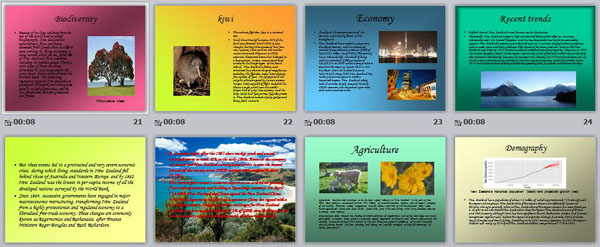New Zealand is a country in Southwestern Oceania, southeast of Australia in the South Pacific Ocean, with two large islands.
one smaller island (Stewart Island), and numerous much smaller islands. New Zealand has a total land area of 268,670 sq km and a coastline of 15,134 km.

New Zealand comprises two main islands (called the North and South Islands in English, Te Ika a Maui and Te Wai Pounamu in Māori) and a number of smaller islands located near the centre of the water hemisphere. The North and South Islands are separated by the Cook Strait, which is 20km wide at its narrowest point. The total land area, 268,680 square kilometres (103,738 sq mi), is a little less than that of Italy and Japan, and a little more than the United Kingdom. The country extends more than 1,600 kilometres (1,000 miles) along its.
New Zealand is one of the most recently settled major land masses. The first settlers of New Zealand were Eastern Polynesians who came to New Zealand, probably in a series of migrations, sometime between around AD 800 and 1300.Over the next few centuries these settlers developed into a distinct culture now known as Māori. The population was divided into Iwi (tribes) and hapū (subtribes) which would co-operate, compete and sometimes fight with each other. At some point a group of Māori migrated to the Chatham Islands where they developed their own distinct Moriori culture.
The first Europeans known to have reached New Zealand were Dutch explorer Abel Janszoon Tasman and his crew in 1642.Several of the crew were killed by Māori and no Europeans returned to New Zealand until British explorer James Cook's voyage of 1768–71.Cook reached New Zealand in 1769 and mapped almost all of the coastline. Following Cook, New Zealand was visited by numerous European and North American whaling, sealing and trading ships. They traded European food and goods, especially metal tools and weapons, for Māori timber, food, artefacts and water. On occasion, Europeans traded goods for sex. Māori agriculture and warfare were transformed by the potato and the musket, although the resulting Musket Wars died out once the tribal imbalance of arms had been rectified. From the early nineteenth century, Christian missionaries began to settle New Zealand, eventually converting most of the Māori population, who had become disillusioned with their indigenous faith by the introduction of Western culture.
Until 1911, New Zealand used the same national coat of arms as the United Kingdom. When New Zealand became a Dominion in 1907, it was decided that a new Coat of Arms was required, and a design competition was held. Since being granted its own arms in 1911, New Zealand's arms have remained similar to the current design, with minor changes in 1956.
Since 1911, the central shield has remained unaltered: a quartered shield containing in the first quarter four stars representing the Southern Cross constellation, as depicted on the national flag, but with the stars in different proportions; in the second quarter, a golden fleece representing the farming industry; in the third, a wheat sheaf representing agriculture; and in the fourth, two hammers representing mining and industry. Over all this is a pale, a broad vertical strip, with three ships representing the importance of sea trade, and the immigrant nature of all New Zealanders.
Before 1956, the shield was identical, but the surrounding features were different. The crest was a demi-lion (the upper half of a rampant lion) holding the British Union Flag, and the scroll at the shield's base featured the then motto of the country, "Onward". Early renditions of the Coat of Arms are often featured with more stylised scrolling rather than fern leaves.
The original supporters were also slightly different. The woman had reddish-brown hair, and both figures faced forward rather than towards the shield. Though there is no direct documentary evidence, it is likely that the original model for the woman was Wellington socialite Alice Spragg. The model for the Māori warrior is unknown.

 Получите свидетельство
Получите свидетельство Вход
Вход
















































 New Zealand (4.75 MB)
New Zealand (4.75 MB)
 1
1 522
522 75
75 Нравится
0
Нравится
0


